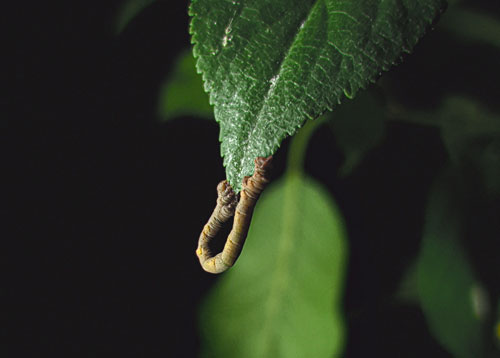Caterpillars are one of the main victims of artificial light at night, say scientists.
The increased illumination gives their predators – insects and birds – an unfair advantage, leading to falling populations of moths.
The researchers from Cornell University in the USA placed placed more than 550 soft clay caterpillar models – lifelike replicas – in a forest setting to ascertain how the mockups were attacked and hunted by predators, compared to a control group.
‘We measured predation rates on the clay caterpillars – which look like the real thing,’ said John Deitsch, who conducted the research in the nearly pitch-dark White Mountains of New Hampshire.
‘Predators left marks on the clay. Predation rates on clay caterpillars and the abundance of arthropod predators were significantly higher on the artificial light at night treatment plots. This suggests an increase of mortality pressure on caterpillars.’
Deitsch and Sara Kaiser, research ecologist and director of the Hubbard Brook Field Ornithology Program at the Cornell Lab of Ornithology, co-authored the research, entitled ‘Artificial Light at Night Increases Top-Down Pressure on Caterpillars: Experimental Evidence From a Light-Naive Forest.’
The caterpillar models, made from green, extruded clay to mimic the colour and size of Noctuidae (owlet moths) and Notodontidae (prominent moths) caterpillars, are commonly found at the Hubbard Brook Experimental Forest. The soft clay easily allows for imprints so that the scientists can determine if predators – like arthropods, insects or birds – landed on the model or tried to take a bite.
While effects of artificial light at night have often been studied on adult insects (such as moths), the larvae (caterpillars) have seen little research.
Of the 552 clay caterpillars deployed and glued to leaves to look authentic, 521 models were recovered and 249 (47.8 per cent) showed predatory marks from arthropods, during the summer-long nighttime study.
Further, the research found that caterpillar predation rates were 27 per cent higher on experimental plots – compared to the control areas in the same forest – that had 10 to 15 lux (about the brightness of a streetlight), which is an illumination measurement for LED lighting.
Given the global ubiquity of artificial light at night, increased threat to caterpillars is yet another ecological problem for lepidoptera, in addition to habitat loss, agricultural-chemical pollutants, invasive species and climate change, according to the paper.
Caterpillars are the most vulnerable at that larval stage. ‘They are eating leaves and growing in order to mature to the next stage,’ Kaiser said, explaining that real-life caterpillars can move around leaves to avoid detection, but the scientists sought to understand predators when larvae were illuminated.
‘When you turn on a porch light, you suddenly see a bunch of insects outside the door,’ Kaiser said. ‘But when you draw in those arthropod predators by adding light, then what is the impact on developing larvae? Top-down pressure – the possibility of being eaten by something.’
Funding was provided by the Rochester Academy of Science, the Society for Integrative and Comparative Biology and the College of Agriculture and Life Sciences. For Deitsch, the research was made possible by an Experiential Learning Grant from the Cornell Lab of Ornithology Ivy Scholars Fund.
• Remanufacturing Lighting is the subject of a special one-day conference organised by Recolight and taking place on Thursday 27 April 2023 at the Coin Street Conference Centre in London. This CPD-approved event will give you the tools, insights and contacts make a success of luminaire reconditioning and reuse. You’ll learn how to sell the concept of reconditioned lights, develop best practice policies, comply with the standards, set up a testing regime for reused luminaires and remanufacture fittings at scale. The gathering will also give you inspiration from real world projects which prove that remanufacturing can be a success everyone. You’ll also meet key players in the remanufacturing industry network with specifiers with the power to get your products into projects. See more HERE.

